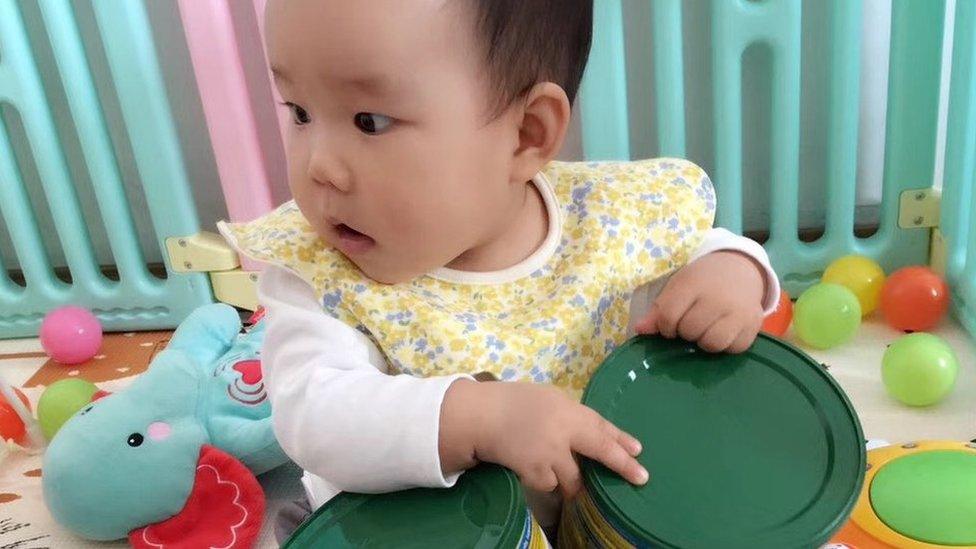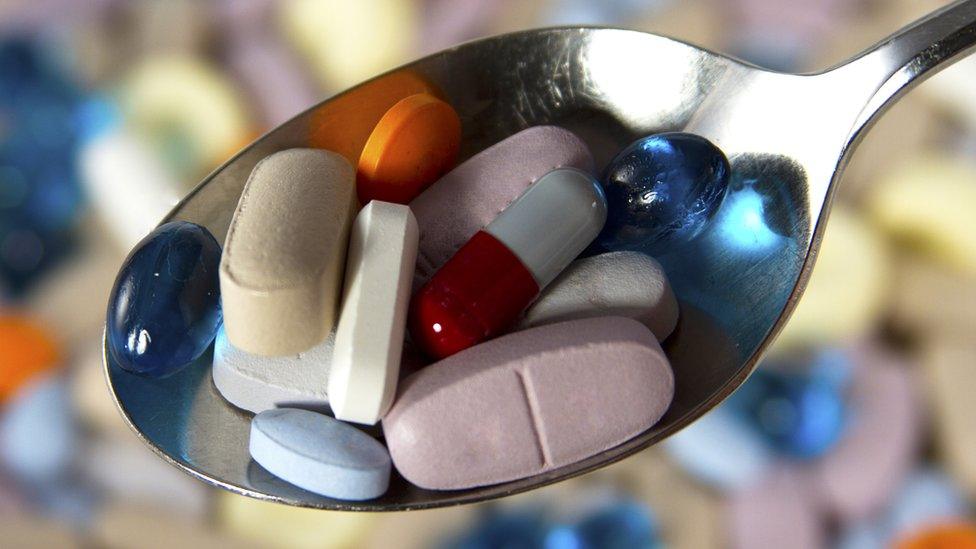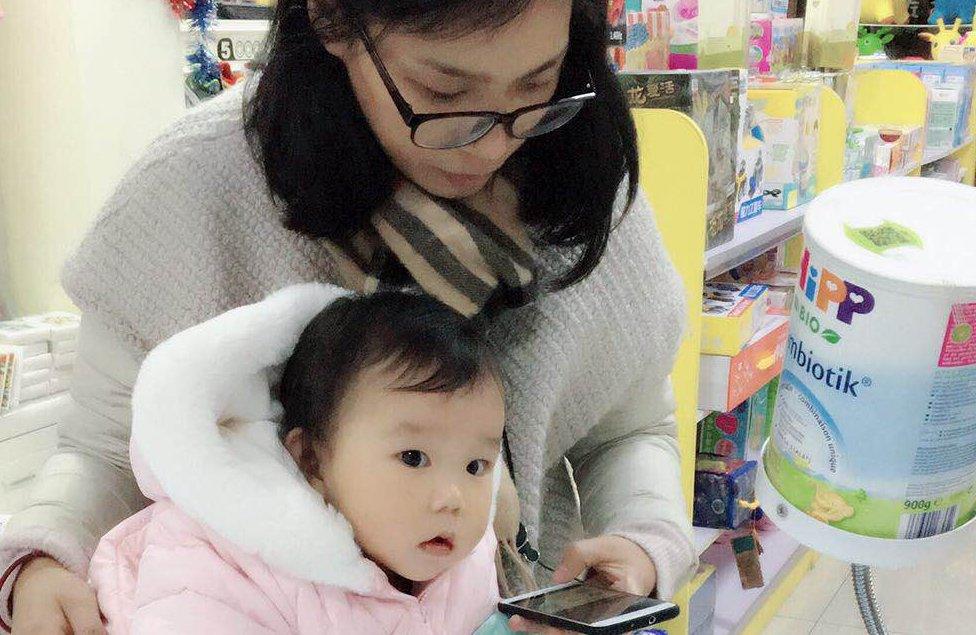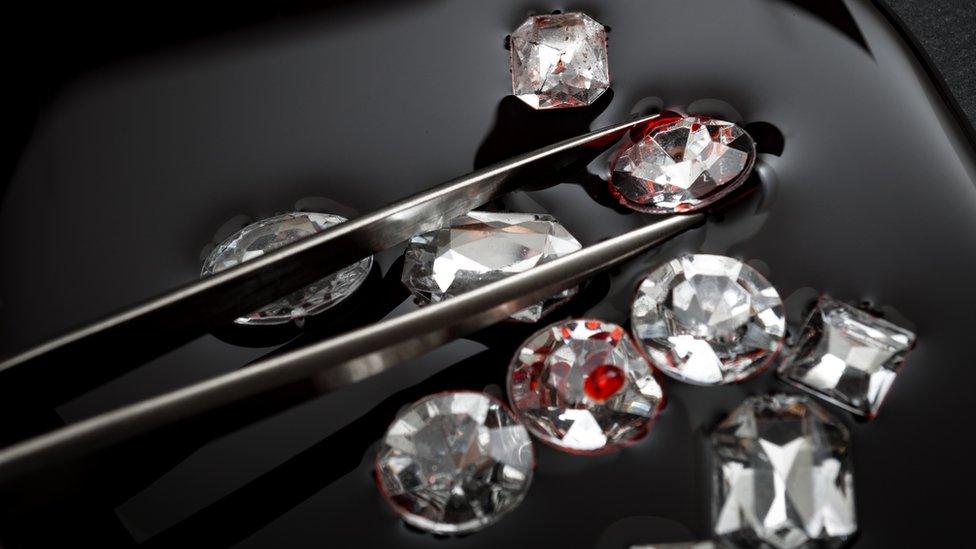The battle against deadly fake goods goes hi-tech
- Published

Her parents worry about the risks facing 11-month-old Yiyi when she has baby formula
"I have strong concerns over infant formula," admits Zeng, mother of 11-month-old Yiyi.
She is worried about the health risks her daughter faces from fake baby milk. Her concerns illustrate the human aspect of a lucrative global scandal which has seen millions of dollars-worth of different dodgy products hit the market.
And while fake jeans may only prove to be a fashion disaster, counterfeit medicines can prove extremely harmful.
But technology is coming to the rescue; specifically blockchain. It's being used to verify the authenticity of baby formula, medicines and even to help reduce the harmful trade in blood diamonds. It's also being used to help keep our fish supply fresh.
Zeng and her husband Shi live in Jiaxing, a city of 1.2 million not far from Shanghai. Like other new parents, they worry about using formula baby milk after a number of high-profile contamination incidents in the last decade.

Fake medicine can prove extremely harmful
Melamine is sometimes added to fool government protein tests. But it also causes kidney stones and renal failure. Some 300,000 babies fell ill in 2008 from melamine-tainted formula, with occasional scares since.
"I cannot fully trust the baby store, supermarkets, or the internet. I know cash sometimes drives people to do evil," says Zeng, who asked for her full name to be withheld because of the sensitive subject.
But she discovered that blockchain could be used to verify the safety of formula - by using her phone to link a chip containing proof of the formula's authenticity.
A small wire in the formula label wraps around the container, explains Alexander Busarov, chief executive of blockchain startup WaLiMai. "You cannot open the can of baby food without breaking the label," he says.
The wire acts as an antenna for a signal from an RFID chip, which a smartphone can read. The chip, like some bank cards, generates a new code each time it is scanned. Authenticating takes about two seconds, says Mr Busarov, then you get the result, the logistics details, a picture of the product and where it was labelled.

Zeng uses her phone to check the authenticity of formula she buys for her daughter
The label slightly increases the cost of the product but it is a cost consumers are willing to bear, says Mr Busarov. "With jeans you don't really care if they're fake. But under no circumstances would you want you or your baby to consume fake food or baby formula."
Blockchain offers a powerful way to verify pharmaceuticals, says Suzanne Somerville, from a project called MediLedger, a joint venture between San Francisco start-ups, TheLinkLab, and Chronicled.
It uses a blockchain to track the movements of pharmaceuticals and "help deliver truth in these transactions in decentralised way - parties who don't necessarily want to work together can agree on the authenticity of these events," says Ms Somerville.
So far, three of the 10 largest US pharmaceutical companies have signed up. Two wholesalers responsible for more than 50% of prescription drug movements in America have, too.
But what if some of this data is proprietary, and a company doesn't want it all shared? In August, MediLedger's team discovered a way to verify a drug's provenance history, without revealing logistics and price information to competitors, says Ryan Orr, chief executive of Chronicled.
"Traditional, centralised databases are like castles with moats," says Mr Orr, "a hacker will always find a clever way to sneak inside."
With blockchain, he says, so long as a majority of players and actors are trustworthy, they can keep malicious ones from tampering with the system.

'Blood diamonds' are mined to fund armed groups
Blockchain is also being used to combat armed groups in the Central African Republic which are making $3m-$6m a year from conflict diamonds, according to the Washington DC-based Enough Project.
In 2003, the United Nations set up the Kimberley Process to establish standards, in force in 81 countries, to ensure traded diamonds aren't "blood diamonds" mined to finance armed groups. But it involves governing the $80bn a year world diamond market with a paper-based certification system.
And fake paperwork can be obtained for a bribe.
Leanne Kemp, an Australian who in 2015 founded a company called Everledger, has now encrypted the distinguishing features of 1.8 million diamonds and their provenance on a blockchain.
More than 40 features are logged to create a fingerprint for each diamond, logging it from mine to ring.
"I see it as a technical rewiring of trust - a gentleman's handshake and a promise about a diamond's authenticity or coming money is no longer enough," says Leanne Kemp.
More Technology of Business

In Dublin, blockchain is being used to battle a tide of fake and less-than-fresh fish.
A quarter of the cod and haddock for sale in the Irish city's supermarkets, takeaways and fishmongers are a completely different species than advertised, researchers found. Another problem is tracing fish that has gone off, and warning vendors they may have received bad fish.
"All food comes out of the ocean healthy - it's what you do with it when you take it out of the water that causes problems," says Ron Calonica, a seafood industry veteran who co-founded Earth Twine, which traces seafood movements using RFID chips and creates a blockchain.
A major retailer's recall can cost $10m, and take six days to trace, says Mr Calonica, but using a blockchain you can pinpoint where all of a particular shipment ended up.
So not only can blockchains give us better fish, but they can make other supply chains less fishy, too.
Follow Technology of Business editor Matthew Wall on Twitter, external and Facebook, external